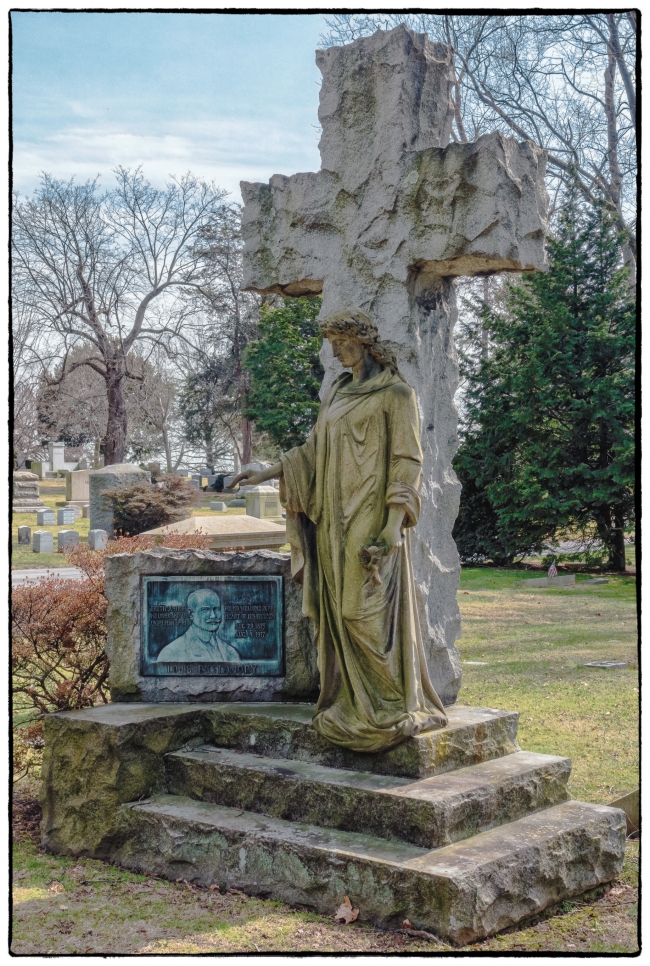We were wandering around trying to find Irving Berlin’s grave when I came across this monument. What caught my attention was the combination of a rough hewn cross; a standing figure; and a metal (brass?) plaque bearing Mr. Bustanoby’s likeness and the words: TRUTH JUSTICE HE LOVED AND HIS UNSELFISH SPIRIT FOUND WELCOME IN THE HEART OF HIS FRIENDS. AUG 29 1873 – AUG 4 1917.
This marker, however, represents something which I always find to be very appealing: a minor monument (it doesn’t even make the rather extensive list in the National Register of Historic Places Registration Forms for Woodlawn), which has an interesting story behind it.
A post on The Historians entitled LOST INGREDIENTS: Forbidden Fruit has this to say about him:
Basque-born Louis Bustanoby, who owned the Café des Beaux Arts at 80 West 40th Street in New York before his untimely death, in 1917, at the age of 44 in his apartment above the restaurant. Opened in 1901, Bustanoby’s establishment was considered one of the city’s finest “lobster palaces”. The famed dining duel between Diamond Jim Brady and actress Lillian Russell took place there. But it was in 1911, that the restaurateur came up with the perfect business model: he added a dance floor in the cellar that employed “gigolos” to escort a new clientele through the latest dance steps. The most famous gigolo was the young and then-unknown Rudolph Valentino.
His new clientele? Women. Bustanoby (nicknamed: Bust Anybody) installed the world’s first lady’s bar, a place where respectable women could drink the offerings of bartenders François and Gabriel, who catered to their whims. Sazeracs, New Orleans Fizzes, and vividly-hued concoctions where the most popular after an afternoon of shopping. As Françcois noted: “They wanted pearl-colored drinks, amethyst drinks, opaline drinks, and it keeps the establishment busy trying to think up new color combinations.”
Even before the ladies’ bar was open, Bustanoby offered a Forbidden Fruit Cocktail—reputedly his own invention—so wives could savor a special sip whilst their husbands mused over a cognac or other strong digestif. We’ve only found one recipe for this libation in Boston restaurateur Louis Muckensturm’s 1906 book Louis’ Mixed Drinks:
Forbidden Fruit. Take half a grapefruit. Remove the pulp and turn the skin inside out, so as to form a small bowl. Put in two lumps of sugar and two liqueur-glasses of brandy. Set fire to the brandy, and when burnt pour the liquid in a liqueur-glass and serve while hot. For each extra person add one liqueur-glass of brandy and half a lump of sugar.
The restaurant must have been quite something. On the Town in New York: The Landmark History of Eating, Drinking and Entertainments from the American Revolution to the Food Revolution by Michael and Ariane Batterberry. describes it as follows:
Forty-second Street became the hub of the new theatres and the great “entrance” restaurants. Principal among these were Shanley’s, on that part of Times Square then called Longacre Square, run by the Shanley brothers; Churchill’s known for its impeccable food and popular owner, “Cap Churchill” and ex-policeman; and Bustanoby’s Cafe des Beaux Arts, on Fortieth Street and Sixth. Jacques (Note: opinions seem to vary as to whether it was Louis or Jacques who founded the women’s bar) Bustanoby introduced the first and possibly the last women’s bar, at which only women could order, and for which his license was almost revoked. The lawyer who defended him on the occasion was none other than the young James. J. Walker. Dancing between course proved a more felicitous innovation and, to cut the ice, the host himself executed exhibition numbers with musical comedy stars. Bustanoby also featured “soirees artistiques” at which Lillian Russell, Anna Held, Maxine Elliot, Douglas Fairbanks, David Warfield, Vernon and Irene Castle and Isadora Duncan all performed. Reggie Vanderbilt staged his horse-show parties at the Beaux Arts, clearly the right place for cutting up, and on historic evening he led in a hansome cab horse to be the guest of honor.
I also came across this little tidbit from New York Times, Monday, August 1917:
Woman Hints at Murder. Telephones Coroners Office Louis Bustanoby Was Poisoned.
A woman called the Coroner’s office last night and told Jacob Anekstein the Coroner’s cleark that she knew that Louis Bustanoby, the restauranteur who died on Saturday in his apartment 80 West Fortieth Street, had been killed by slow poisoning.
Anekstein asked her who she was and she replied that she was Mr. Bustanoby’s sister-in-law nd hung up the telephone received. Anekstein traced the call to a public booth in a drug store at 180th Street and Broadway. Coroner Hellenstein was told of the mysterious call, and he asked the Detective Bureau to make an investigation.
Later the Coroner said Mr. Bustanoby had been sick for six years and had been attended by some of the best physicians in New York and that they had reported to him that Mr. Bustanoby had died of natural causes. He intimated that no attention wold be paid to the woman’s request for an autopsy.

